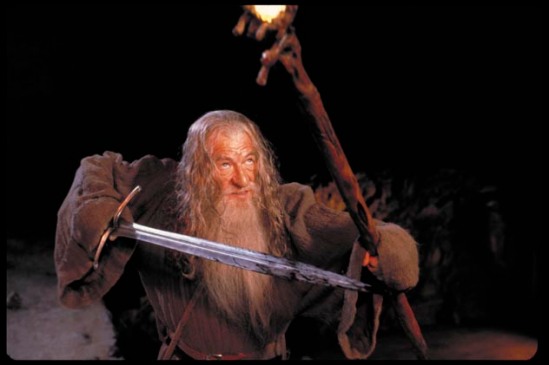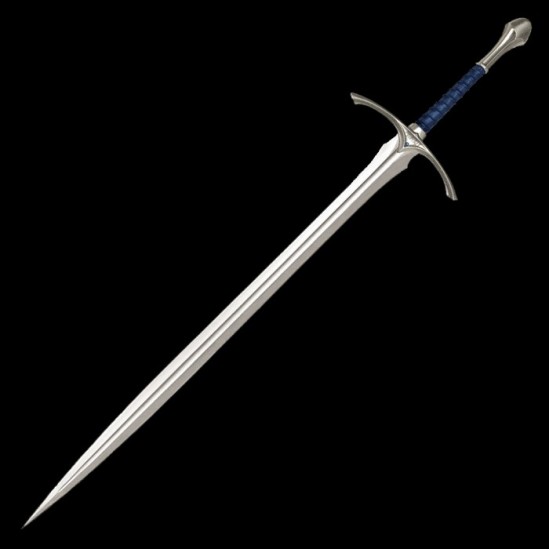GLAMDRING

The Balrog made no answer. The fire in it seemed to die, but the darkness grew. It stepped forward slowly onto the bridge, and suddenly it drew itself up to a great height, and its wings were spread from wall to wall; but still Gandalf could be seen, glimmering in the gloom; he seemed small, and altogether alone: grey and bent, like a wizened tree before the onset of a storm.
From out of the shadow a red sword leaped flaming. Glamdring glittered white in answer. There was a ringing clash and a stab of white fire. The Balrog fell back and its sword flew up in molten fragments. The wizard swayed on the bridge, stepped back a pace, and then stood still.
“You cannot pass!” he said.
—J.R.R. Tolkien, The Lord of the Rings
In the Trollshaws of Eriador, found alongside Orcrist and the short sword later to be named Sting, Gandalf the Grey claimed a remarkable sword for himself. Covered in blood, it would later be examined by Elrond, in Rivendell, and identified as one of the most heralded and feared blades in the history of Middle Earth — Glamdring, the Foehammer.
Glamdring was the sword of Turgon, King of Gondolin, who wielded it with great strength and valour during The Fall of Gondolin. The orcs so feared the weapon, naming it Beater in their vile tongue, that it was still woefully remembered some six thousand years later.
This fabled sword was put to good use by Gandalf the Grey and it served him for nearly a century. He used it to slay the Great Goblin and wielded it during The Battle of Five Armies. The wizard bore it in the Battle of the Chamber of Mazarbul and faced Durin’s Bane, the dread Balrog, at the Bridge of Khazad-dûm, with it held firmly in hand. It was ever-present throughout the War of the Ring, a deadly companion to the great wizard during those dark and troubling times.

The sword itself is given but minute description by the author. In The Hobbit, Tolkien referred to Glamdring as having a beautiful scabbard and jeweled hilt, while in Unfinished Tales Turgon’s Blade is described as white and gold, sheathed in a ruel-bone scabbard.
The movie version of the sword depicted in the Peter Jackson film series, being three Hobbit films and the Lord of the Rings trilogy, is a thing of beauty. Wielded by Sir Ian McKellan’s Gandalf, Glamdring is an elegant long sword designed by Ben Wootten and forged by Master Swordsmith Peter Lyon.
With a blade nearly thirty-seven inches and an overall length of just over four feet, Glamdring is a formidable weapon. And, as it weighs just a tad under four pounds, it is comfortable to bear for an extended melee.
“Peter Lyon made weapons that were so exquisite and so rich in culture and subtlety of use that the actors grew to find it a complete delight using these weapons.”
— Richard Taylor, The Lord of the Rings Special Effects Specialist

While in The Hobbit it is said that Elrond translates the rune inscription on the blade, said by Tolkien scholars and enthusiasts to be, most likely, Gondolin Runes (which makes sense), it is only the sword’s name and previous owner past on.
The guard of the Wootten/Lyon sword is inscribed with a Sindarin phrase in cirth runes which translate as:
“Turgon aran Gondolin tortha gar a matha i vegil Glamdring gûd daedheloth, dam an Glamhoth”, or in the common tongue as “Turgon, king of Gondolin, wields, has, and holds the sword Glamdring, Foe of Morgoth’s realm, Hammer of the Orcs”
To be honest, this is troublesome for Tolkien purists as the movie sword not only presents a different rune type than would be expected, but also the runes depict Sindarin words as opposed to Quenya, which was the language of Gondolin. Regardless, it is a masterful sword and an impressive work of art, and though it varies from the published description on several points, its essence is true to form.
Glamdring has long been one of my favorite fantasy weapons. The true power of a sword, even a magical one, lies in who wields it and its greatness is measured by the adversaries it has faced. In that, Glamdring surely deserves any and all accolades showered upon it.
Whether in the hands of Turgon or Gandalf, Glamdring served its bearer well and true, facing the cruel and sinister forces of both Morgoth and Sauron, while never wavering.
Glamdring is a sword that should forever be remembered alongside the great swords of fantasy literature — Excalibur, Stormbringer, Durendal, and so many others.





